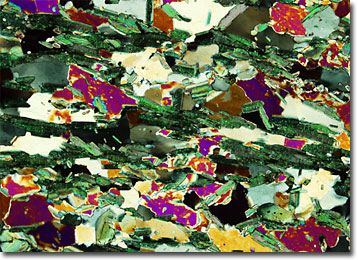Polarized Light Microscopy Digital Image Gallery
Fuchsite
The common silicate mineral muscovite is usually colorless, but also occasionally appears in a variety of hues that range from pale gray to a rosy red. The green variety of muscovite is known as fuchsite.

Similar to other muscovites, fuchsite, which often occurs in scaly sheets or as small crystals, contains aluminum and potassium. The emerald-like hue of the mineral is due, however, to the relatively large amount of chromium it contains. Indeed, samples of fuchsite have been found that contain up to 6 percent of the metallic element, while other muscovites generally only exhibit trace amounts. Somewhat soft, fuchsite crystals are pleochroic and exhibit perfect cleavage.
Fuchsite is not commonly utilized for commercial applications, but due to its beautiful coloring and glassy luster, the mineral is a component in several rocks that are polished and sold as gemstones. Greenlandite, for instance, is the nongeologic name of a green to bluish-green quartzite from Greenland that depends upon fuchsite for its color. Similarly, the substance marketed as Indian jade is often quartzite interspersed with green fuchsite flakes. The mineral fuchsite is sometimes alternatively sold as a healing crystal and ascribed with various mystical powers.
